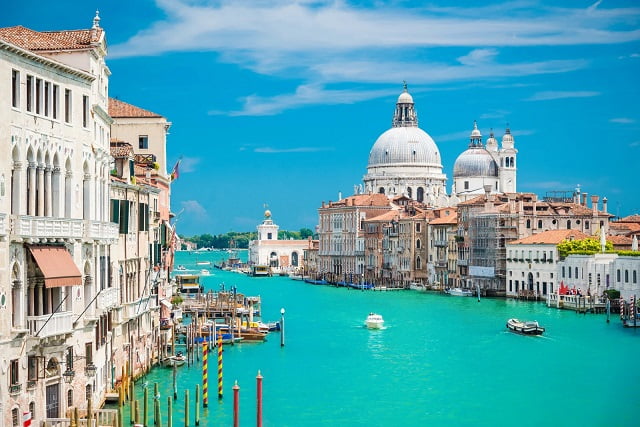Captivating readers with the idea of traveling to beautiful Italy, this introductory section sets the tone for an informative blog post on the cost aspects that come with such a journey. From flights and accommodations to dining experiences and hidden gems, this article aims to provide readers with a comprehensive budget guide to plan their expenses when exploring Italy.
Whether you’re dreaming of walking through ancient Roman ruins or indulging in authentic Italian cuisine, understanding the cost of travel is essential for making your Italian getaway a reality.
The Ultimate Italy Travel Budget Guide
Italy is a country that offers a wide range of experiences, from exploring ancient ruins to indulging in delicious cuisine. But before embarking on your Italian adventure, it’s important to plan your expenses and create a budget. In this section, we will break down the various cost components of traveling to Italy and provide you with a comprehensive budget guide.
- Flights: The first step in planning your trip to Italy is finding affordable flights. On average, flights from major cities in the United States to popular Italian cities like Rome or Milan can cost anywhere between $500 and $1,000 round trip.
However, by using flight comparison websites and being flexible with your travel dates, you can often find great deals. It’s also worth considering flying into smaller airports in Italy or nearby countries and then taking a domestic flight or train to your final destination. - Accommodation: Another significant expense when traveling to Italy is accommodation. The cost of hotels can vary greatly depending on the city and time of year you visit. On average, a mid-range hotel room in major Italian cities can cost between $100 and $200 per night.
However, there are several alternatives for budget-conscious travelers such as hostels or apartments for rent through platforms like Airbnb. These options offer more affordable prices while still providing comfort and convenience. - Food: Italy is renowned for its culinary delights, but dining out every day can quickly add up. On average, expect to spend around $15-$30 per person for a meal at a moderately priced restaurant.
To save money on food expenses without sacrificing authenticity, consider buying fresh produce at local markets and preparing simple meals yourself or opt for the famous “aperitivo” culture where you can enjoy small bites along with a drink at more affordable prices.
By planning ahead and keeping these costs in mind, you can ensure that your trip to Italy fits within your budgetary constraints without compromising on experiencing all that this beautiful country has to offer. With this comprehensive budget guide, you can explore Italy’s historical sites, indulge in delicious cuisine, and create unforgettable memories without breaking the bank.
Flights and Transportation Costs
When planning a trip to Italy, one of the first considerations is how to get there and navigate within the country. Flights to Italy can vary greatly in cost depending on factors such as the time of year, departure city, and airline. As a popular tourist destination, many major airlines offer direct flights to cities like Rome, Florence, Milan, and Venice. It’s always advisable to compare prices and be flexible with travel dates to find the best deals.
Once you arrive in Italy, there are various transportation options available for getting around. One of the most convenient ways is by train. The Italian rail network is extensive and efficient, connecting major cities as well as smaller towns. High-speed trains like Frecciarossa are more expensive but can save you time if you have limited days for sightseeing.
For those on a tighter budget or looking for a more immersive experience, buses can be a cost-effective option. Companies like FlixBus offer affordable fares between popular tourist destinations within Italy as well as neighboring countries.
Another option for shorter distances is taking regional trains or local buses. While these may take longer than intercity trains or buses, they often provide an opportunity to see more of the countryside and lesser-known areas at a lower cost.
Navigating public transportation within cities like Rome or Milan usually involves using metro systems or buses. Buying day passes or multi-day tickets can help save money if you plan on using public transportation frequently during your stay.
To find affordable flight deals and navigate public transportation effectively, it’s essential to do some research beforehand. Websites like Skyscanner and Kayak can help compare flight prices and find the cheapest options available. Additionally, familiarizing yourself with local transport systems by visiting official websites or using mobile apps like Moovit can ensure that you make informed decisions when traveling around Italy.
By considering these various options for flights and transportation within Italy, travelers can plan their budgets accordingly and make the most of their time exploring this beautiful country. Whether you choose to splurge on a direct flight or opt for a scenic train journey, Italy is sure to captivate with its rich history, stunning landscapes, and delectable cuisine.
Accommodation Options
When planning a trip to Italy, one of the most important aspects to consider is finding the perfect place to stay. Italy offers a wide range of accommodation options that cater to different budgets and preferences. Whether you are looking for luxury hotels, cozy bed and breakfasts, or budget-friendly hostels, Italy has something for everyone.
- Hotels: Italy is known for its exquisite luxury hotels that provide unparalleled comfort and service. From lavish five-star establishments in popular cities like Rome, Venice, or Florence to charming boutique hotels nestled in the countryside, there is no shortage of options for those seeking a luxurious stay.
However, it’s important to note that these accommodations often come with a higher price tag. On average, prices can range from $200 to $500 per night depending on the location and season. - Bed and Breakfasts (B&Bs): For a more intimate and authentic experience, staying at a bed and breakfast can be a great choice. B&Bs are often family-run establishments that offer cozy rooms with breakfast included in the price. These accommodations can be found throughout Italy and are particularly popular in rural areas or smaller towns. Prices for B&Bs vary depending on location but generally range from $70 to $150 per night.
- Hostels: For budget-conscious travelers or those seeking a more social atmosphere, hostels are an excellent option. Hostels in Italy provide affordable dormitory-style rooms as well as private rooms with shared facilities such as bathrooms and common areas.
They are commonly found in major cities and tourist destinations like Rome or Milan but can also be found in smaller towns catering to backpackers exploring off-the-beaten-path locations. Prices for hostels vary but generally start around $20 per night for a dorm bed.
In addition to these three main accommodation options, there are also vacation rentals such as apartments or villas that offer a home-away-from-home experience. These can be an ideal choice for families or those planning an extended stay in Italy. Prices for vacation rentals vary depending on size, location, and amenities.
When looking for the perfect place to stay, it is advisable to book in advance, especially during peak seasons when prices tend to be higher and availability may be limited. Popular areas such as the Amalfi Coast or Tuscany can get booked up quickly, so it’s essential to plan ahead. Additionally, consider staying in lesser-known neighborhoods or towns outside of city centers to find more affordable options.
Overall, Italy offers a plethora of accommodation choices to suit every budget and preference. Whether you’re seeking luxury and elegance or simplicity and affordability, finding the perfect place to stay in Italy is key to ensuring a memorable and enjoyable trip.
The Italian Culinary Experience
Italy is renowned for its delectable cuisine, and no trip to the country would be complete without indulging in its culinary delights. This section of the article will focus on dining and food expenses in Italy, providing readers with insights into average costs and tips for finding affordable yet authentic dining experiences.
Exploring the Diverse Culinary Scene
Italy’s rich culinary heritage offers a diverse range of flavors and regional specialties. From indulging in homemade pasta dishes in Tuscany to savoring fresh seafood along the Amalfi Coast, there are endless opportunities to tantalize your taste buds. When dining out in Italy, it’s important to keep in mind that prices can vary depending on the region and level of establishment.
Average Costs for Eating Out
When budgeting for dining expenses, travelers should consider that eating out at restaurants in tourist-heavy areas or popular cities like Rome or Florence will generally be more expensive compared to smaller towns and countryside regions. On average, a meal at a mid-range restaurant can cost between €15-€30 per person.
For those looking to save money without compromising on taste, opting for lunch menus or “menu del giorno” specials offered by many restaurants can be a cost-effective choice.
Finding Cheap Eats
While Italy is famous for its fine dining experiences, delicious street food and local markets offer budget-friendly options without sacrificing authenticity. Grabbing a slice of mouthwatering pizza from a street vendor or devouring freshly prepared paninis from local sandwich shops can give you a true taste of Italian street cuisine at affordable prices.
Another way to save on food expenses is by exploring the local markets where you can find fresh produce, cheese, cured meats, and other ingredients to create your own meals. Not only will this be cost-effective but it also allows you to immerse yourself in the local culture by interacting with vendors and experiencing the vibrant atmosphere of Italian markets.
Sightseeing and Attractions
Italy is known for its rich heritage and historic landmarks, making sightseeing and exploring a must-do for any traveler visiting the country. In this section, we will delve into the various tourist attractions in Italy and provide information about their entrance fees. Additionally, we will suggest ways to make the most of sightseeing while keeping expenses in check.
One of Italy’s most iconic attractions is the Colosseum in Rome. Entrance fees for adults are around 16 euros, with discounted rates available for students and seniors. It is advisable to purchase tickets online in advance to avoid long queues on-site. Other popular landmarks in Rome include the Vatican museums and St. Peter’s Basilica, which have separate entrance fees. Exploring these landmarks allows visitors to marvel at art masterpieces and experience the grandeur of centuries-old architecture.
In Florence, another must-visit destination in Italy, tourists flock to see Michelangelo’s David at the Accademia Gallery. The entrance fee for adults is approximately 12 euros, with discounts available for EU citizens under 26 years old. The Uffizi Gallery is also a highlight in Florence, showcasing an impressive collection of Renaissance art. Entrance fees vary depending on the time of year and can range from 8 to 20 euros.
Venice offers a unique sightseeing experience with its multitude of canals and stunning architecture. Visitors often enjoy taking a gondola ride or strolling across the famous Rialto Bridge. While exploring Venice’s attractions on foot is free, gondola rides can be quite pricey; however, they provide an unforgettable experience of gliding through the city’s picturesque waterways.
To get more value from sightseeing expenses, it is worth considering purchasing city passes or combination tickets that offer access to multiple attractions at discounted rates. These passes can often include public transportation as well, making it convenient for travelers to get around while maximizing their time spent sightseeing.
By planning ahead and budgeting for entrance fees to the various attractions, travelers can immerse themselves in Italy’s rich heritage without breaking the bank. It is also worth noting that some attractions offer free admission on certain days or during specific hours, so it is advisable to check their websites or inquire at local tourist information centers for updated information. With proper research and planning, exploring Italy’s heritage can be both enriching and cost-effective.
Hidden Gems
Italy is renowned for its popular tourist destinations such as Rome, Florence, and Venice. However, there are also hidden gems scattered throughout the country that offer a more affordable and off-the-beaten-path experience. These destinations provide an opportunity to explore lesser-known areas of Italy while still immersing yourself in its rich culture and history.
Off-the-Beaten-Path Destinations
One of these hidden gems is the region of Abruzzo, located east of Rome. This area boasts stunning national parks, charming medieval villages, and picturesque landscapes. With fewer tourists than other parts of Italy, Abruzzo allows visitors to experience authentic Italian life without the crowds. The cost of accommodation and dining in Abruzzo is often much lower compared to more popular locations.
Another hidden gem is Matera, located in the southern region of Basilicata. This ancient city is famous for its cave dwellings known as “sassi.” Exploring the winding alleys and staircases carved into the rock will transport you back in time. While Matera has gained recognition in recent years, it still remains relatively undiscovered by mass tourism. Visitors can find budget-friendly accommodations in charming boutique hotels or guesthouses.
Affordable Attractions
These hidden gems also offer unique attractions that won’t break the bank. In Abruzzo, you can visit Gran Sasso e Monti della Laga National Park where you can hike through breathtaking mountain trails or enjoy panoramic views from high-altitude plateaus. The entrance fees for national parks in Italy are often quite affordable and provide an opportunity to connect with nature.
Matera offers its own attractions, such as the Rupestrian Churches that feature impressive frescoes from different eras. Many of these churches have minimal entrance fees or are open to public donations. Additionally, simply wandering through Matera’s narrow streets and admiring the architecture is a memorable experience in itself.
Tips for Saving on Hidden Gems
To make the most of these hidden gem destinations without breaking the bank, it’s important to plan ahead and make informed choices. Research budget-friendly accommodation options such as guesthouses, bed and breakfasts, or vacation rentals in smaller towns near these locations. These can often provide a more affordable yet authentic experience compared to larger hotels.
Another tip is to seek out local eateries and street food vendors for delicious meals at lower prices. In these hidden gems, you’re likely to find small restaurants and cafes where locals dine, offering traditional dishes and regional specialties at a fraction of the cost you would pay in more touristy areas.
By exploring these off-the-beaten-path destinations, travelers can add an exciting twist to their Italian adventure while saving money. Whether it’s absorbing the breathtaking landscapes of Abruzzo or delving into Matera’s fascinating history, these hidden gems offer an unforgettable experience that won’t break the bank.
Budget-Friendly Activities and Experiences
Italy is a destination renowned for its rich culture, history, and breathtaking landscapes. Traveling to Italy doesn’t have to break the bank, as there are plenty of budget-friendly activities and experiences that can enhance your Italian getaway without draining your wallet. By being savvy and seeking out affordable options, you can make the most of your trip while sticking to a tight budget.
One of the best ways to experience Italy on a budget is by exploring the country’s vibrant street markets. These markets offer a delightful blend of sights, sounds, and aromas, where you can immerse yourself in the local atmosphere and find unique souvenirs at reasonable prices.
Whether it’s strolling through Florence’s San Lorenzo Market, browsing through vintage shops in Rome’s Porta Portese Flea Market, or sampling fresh produce at Naples’ Mercato di Porta Nolana, these markets provide an authentic Italian experience without breaking the bank.
In addition to exploring markets, taking advantage of Italy’s natural beauty is another cost-effective way to enjoy the country. Italy boasts stunning landscapes that are perfect for outdoor activities such as hiking, cycling, or picnicking.
You can embark on scenic hikes in the Cinque Terre region along coastal trails or explore the lakeside paths of Lake Como. Not only will you get to enjoy incredible views and breathe in fresh air, but these activities often come with little to no cost.
| Activity | Average Cost |
|---|---|
| Exploring street markets | Varies (affordable) |
| Outdoor activities (hiking, cycling) | Free to affordable |
Lastly, embracing local traditions and cultural events can be an enriching and cost-effective way to experience Italy. Many Italian towns and cities host festivals throughout the year, celebrating everything from food and wine to art and music.
Attending these festivals often includes free or low-cost entry to exhibitions, concerts, and performances. Whether it’s the Carnival of Venice, Siena’s Palio horse race, or Florence’s Gelato Festival, these events offer a fantastic opportunity to immerse yourself in Italian culture while staying within your budget.
Italy has endless opportunities for budget-friendly activities and experiences that allow you to enjoy the country without overspending. By exploring street markets, venturing into nature, and embracing local traditions, you can create cherished memories while making the most of Italy on a tight budget. Remember to plan ahead, research affordable options, and embrace the spontaneous moments that make traveling in Italy truly unforgettable.
Getting Around Italy on a Budget
Italy is a country known for its rich history, stunning architecture, and picturesque landscapes. With so much to explore, it’s important to consider transportation options that won’t break the bank. In this section, we will provide insider tips and recommendations on how to get around Italy on a budget.
One of the most cost-effective ways to travel within Italy is by utilizing regional passes. These passes allow travelers unlimited access to public transportation within a specific region, such as the popular ItaliaRail Pass or the Trenitalia Pass.
Regional trains are a convenient and affordable option for moving between cities within the same region, with prices starting as low as €5. It’s also worth considering bus options, as they often offer competitive fares and reach destinations not easily accessible by train.
Another budget-friendly transportation option in Italy is utilizing local transportation. Many cities have excellent public transportation systems, including buses and trams, which can be more economical than taxis or private transfers. For example, Rome has an extensive metro system that can take you to all the major tourist attractions at a fraction of the cost of a taxi.
Of course, one of the best ways to experience Italy is on foot. Most major cities in Italy have compact city centers that are easily walkable. Not only is walking free, but it also allows you to stumble upon hidden gems and discover charming neighborhoods that you might miss while hopping from one tourist attraction to another.
| Transportation Option | Average Cost |
|---|---|
| Regional Trains | Starting from €5 |
| Local Buses/Trams | Varies by city; typically less than €2 per ride |
| Walking | Free. |
Final Thoughts
In conclusion, achieving an unforgettable Italian getaway is not only possible but also within reach for travelers on any budget. This ultimate Italy travel budget guide has provided a comprehensive breakdown of the various cost components to consider when planning your trip. From flights and transportation to accommodation options, dining experiences, sightseeing, and hidden gems, this article has covered it all.
It is important to remember that with careful planning and research, affordable alternatives can be found without sacrificing the quality of your experience. Whether you choose to stay in budget-friendly hostels or indulge in luxurious hotels, Italy offers a variety of accommodations to suit every traveler’s needs.
Additionally, exploring Italy’s rich culinary scene does not have to break the bank. By seeking out local eateries and trying authentic local delicacies, you can enjoy delicious meals without overspending. Similarly, sightseeing in Italy does not need to be expensive if you prioritize popular attractions and plan ahead for any entrance fees.
Ultimately, this guide emphasizes that experiencing Italy on a tight budget is about making smart choices and seeking out affordable alternatives while still embracing the country’s rich cultural heritage. By following the tips provided here and incorporating free or low-cost activities into your itinerary, you can create a truly memorable Italian getaway that suits your individual preferences.
So start planning your trip today with a well-balanced travel budget that allows you to explore all that beautiful Italy has to offer on your own terms. Whether you choose to visit well-known destinations or venture off the beaten path, an unforgettable Italian adventure awaits you.
Frequently Asked Questions
What is the average cost of a trip to Italy?
The average cost of a trip to Italy can vary depending on several factors such as the destination within Italy, the season of travel, the level of accommodation, and personal preferences. On average, however, a trip to Italy can cost anywhere from $1500 to $3000 per person for a week-long trip.
This estimate typically includes accommodation, transportation within Italy, meals, attractions and activities, and some souvenirs.
What is the average cost of a 10 day trip to Italy?
When considering the average cost of a 10-day trip to Italy, it is important to consider that the duration of the trip may impact overall expenses. A 10-day trip allows for more exploration and immersion in Italian culture, but it also means additional costs for accommodation, meals, transportation, and activities.
On average, a 10-day trip to Italy can range from $2000 to $4000 per person. However, it is essential to note that these costs can greatly vary based on individual choices and preferences.
How much would a 12 day trip to Italy cost?
A 12-day trip to Italy offers an extended opportunity to discover various regions and immerse oneself in the country’s rich history and culture. The overall cost will depend on several variables such as accommodations chosen (luxury or budget), dining preferences (fine dining or casual eateries), transportation (rental car or public transport), and excursions planned during the itinerary.
Considering all these factors and allowing for more time in Italy would generally result in an increased budget compared to a shorter stay. On average, a 12-day trip to Italy can range from $2500 up to $5000 per person or more for those seeking indulgences such as upscale accommodations or exclusive experiences.

I’m a passionate traveler, writer, and Italophile. My fascination with Italy’s history, art, and culture has led me on countless adventures across the Italian landscape. Through “I Live Italy,” I share my love for this extraordinary country and aims to inspire others to explore its boundless beauty.




